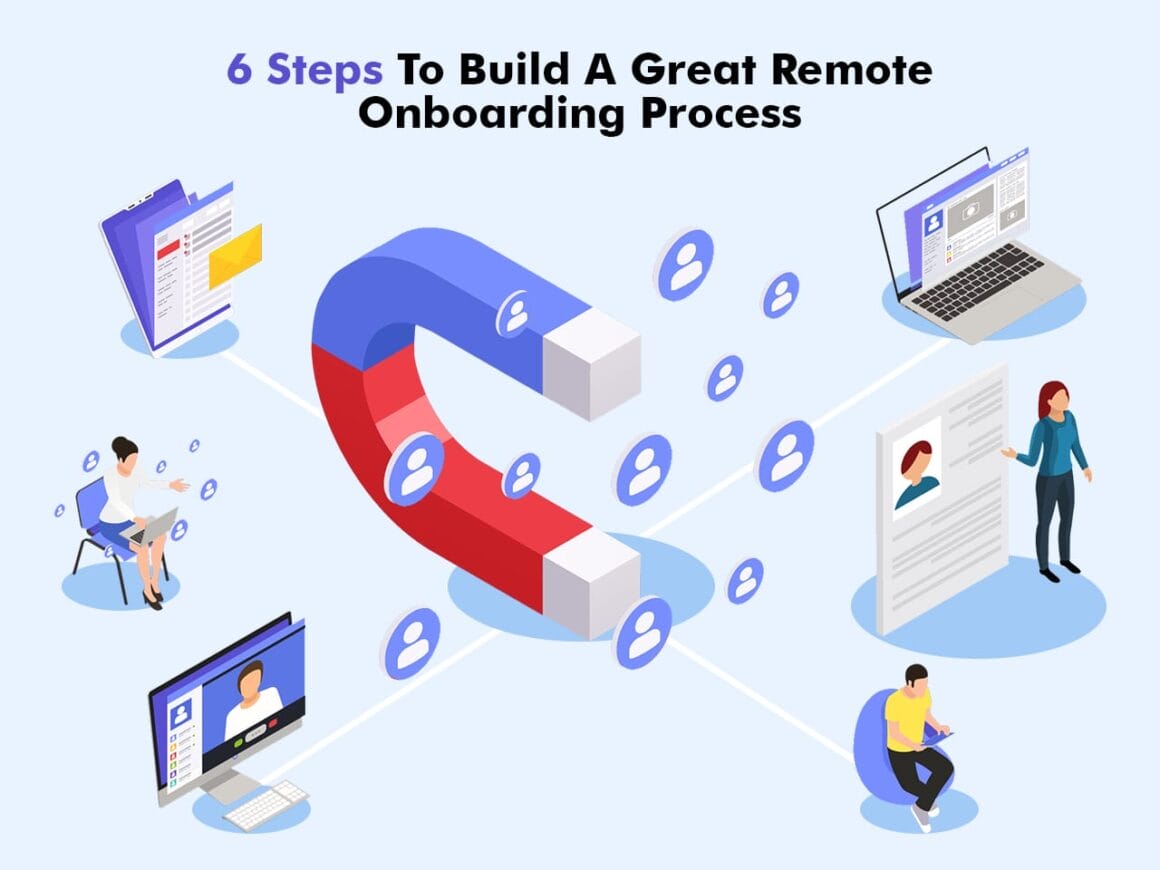The success of an employee’s performance and engagement starts with the onboarding. 80% of new hires who receive poor onboarding plan to quit – especially if they are remote workers.
The traditional handshakes and office tours are replaced by virtual introductions and digital orientations, but the essence of a robust onboarding process remains unchanged—it sets the tone for a new hire’s journey and significantly influences their integration into the company culture.
Let’s explore the key aspects to building a foundation that fosters productivity, engagement, and sense of belonging right from day one.
What is Remote Onboarding?
Remote onboarding is the process of integrating and orienting virtual employees into a company’s culture, workflow, and expectations.
In virtual teams, this onboarding process is conducted through online tools and communication platforms. It involves introducing new hires to their roles, team members, company policies, and procedures, all while facilitating a smooth transition into their new work environment.
Tools and Platforms That Facilitate Effective Remote Onboarding
In the face of remote onboarding challenges, technology indeed emerges as a beacon:
The lack of physical presence can make relationship-building a formidable task. However, video conferencing platforms like Zoom or Microsoft Teams bridge this gap, allowing for more intimate face-to-face exchanges, making introductions warmer and team meetings more personal.
Navigating projects and team dynamics from afar can be like piecing together a jigsaw puzzle without seeing the full picture. Collaborative tools such as Trello, Asana, and Slack make this easier, ensuring new hires are not just spectators but active participants. These platforms serve as virtual hubs, streamlining communication and ensuring everyone stays on the same page.
Moreover, while virtual hires may miss the experience of walking through office corridors, companies are turning to Virtual Reality (VR) for a solution. A VR orientation isn’t just about replicating the office tour. It’s an immersive experience, allowing remote employees to feel the ambiance, witness office dynamics, and even participate in virtual team-building activities.
Lastly, while company handbooks have always been a staple of the onboarding process, their digital counterparts are becoming increasingly important. Digital handbooks, be it in the form of e-books or interactive PDFs, ensure that every policy, every cultural nuance, and every procedural detail is but a click away, making reference swift and hassle-free.
6 Remote Onboarding Steps To Build a Great Process
1. Provide a Virtual Welcome Package
Once the new hire is confirmed, make sure to build a welcome package containing the essential documents, company policies, and overview of the company culture. This will ensure that new hires have all the information they need from the start.
Additionally, new hires need access to all of your systems:
- Documents and policies: Share important documents such as the employee handbook, code of conduct, or any legal paperwork.
- Company culture overview: Provide materials that give insight into the company’s values, mission, and culture to help new hires align themselves with the organization.
- Provide them an email account exclusively for work
- Access to chatting and video conferencing tools – new employees should understand they must create their accounts on each instrument.
- Project management tools: Remote companies use tools such as Basecamp and Asana, but there are several other free project management software you can use.
- Share with new hires your expectations: the goals for the first 30, 60, and 90 days.
During this welcome package you could also include a small gift to make them feel welcomed. This could be a company’s mug, a food gift card, or simply a welcome card.
2. Make a Remote Onboarding Checklist
Organization comes from checklists. So, start by creating a list of steps for the employee and yourself. As a leader, you’re the new hire’s role model, so you’ll need to be prepared with the steps to follow before welcoming them.
A remote onboarding checklist will help employees accomplish tasks during their first weeks without the need to reach out to you every five minutes. This checklist will contain a series of remote meetings, training sessions, and interviews they’ll join during the week.
How to Create a Remote Onboarding Checklist?
- Present the team and its goals. Go through a list of tasks that determine the new hire’s role and responsibilities.
- Provide tutorials for the tools – most remote companies have security, HR, and communication tools they use every day – and help new hires create accounts in all of them.
- Assign the task of preparing a presentation letter – a short note with their name, interests, and hobbies.
- Set guidelines for the new hire to schedule one-on-one meetings with the company’s leadership members and with you.
Once you’ve decided what to include on your checklist, put it together in a template.
3. Include a Virtual Meet-and-Greet
Emphasizing connection lies at the heart of effective remote onboarding practices. Whether it’s orchestrating a virtual water cooler or a casual coffee meeting, allocating time for employees to familiarize themselves with their new team member is crucial.
You can break virtual meet-and-greets into different modules, first introducing the new hire to their team, during another meeting to department heads, and so on.
To make these meetings more lighthearted consider using icebreaker activities or virtual games.
4. Consider Implementing a Mentorship and Buddy System
Depending on the role, you can consider pairing your new hire with mentors or buddies. That way experienced team members can provide guidance, answer questions, and offer more in-depth insights into the company dynamics.
Onboarding buddies main responsibility is to ensure the transition into a new job is as smooth and comfortable as possible.
However, keep in mind that their role is not to be a substitute for a manager or supervisor. They provide support but do not influence the new employee’s work.
5. Regular Check-ins and Feedback
The best way to know how onboarding went and if new hires are feeling comfortable is by directly asking them. Establish a schedule for virtual check-ins, especially during the first weeks, so you can assess their comfort level and address concerns.
Remember that building trust and creating a safe environment is about giving them this space to do so. You can create open channels for feedback, both from the new employee and the onboarding team. This is the best way to improve and refine your current remote onboarding process.
Every week, ask everyone on the team how they’re doing with their tasks, especially those new hires. You’ll be promoting general feedback with the whole team, as well as a feeling of empathy toward recent members. Feedback will allow you to improve the process for future hires continuously.
6. Include Metrics
Clear and specific metrics measure effectiveness in results – especially in your remote onboarding first weeks.
Metrics establish specific goals and their importance. Employers can focus on real numbers to evaluate the new hires’ performance and evolution, while new hires can understand the aims clearly. You should consider a specific platform, a measurable number of results, and time-bound.
Your expectation could be something like this: for our new graphic designer, we expect them to perform new designs on Photoshop (specific platform) with a score from 8-10 (measurable) a week after his first month (time-bound).
Clearly defined and trackable KPIs offer both the employee and the reviewer a concrete framework. These metrics, be they task completion rates, project contributions, or even engagement levels on collaboration tools, provide an objective lens through which performance can be assessed.
The Unique Challenges of Onboarding Employees Remotely
Onboarding in a remote environment introduces its own set of distinct hurdles, different from the traditional face-to-face approach.
One of the primary challenges is the aspect of relationship-building. In the confines of a virtual world, establishing genuine interpersonal connections and cultivating trust can prove more intricate. Without those casual water-cooler conversations or lunch breaks together, fostering a sense of camaraderie among colleagues becomes a more deliberate effort, impacting employee engagement.
Additionally, immersing a new employee in the company’s culture is more complex when they’re not present in a brick-and-mortar office. The subtleties and nuances that make up a company’s ethos might be harder to convey and internalize without the direct experience of day-to-day office life.
The reliance on technology, while essential for remote onboarding, comes with its own set of pitfalls. Technical disruptions or glitches can interrupt the onboarding flow, potentially leaving new hires feeling lost or frustrated. This reliance underscores the importance of robust IT support during the onboarding process.
Boost Your Remote Onboarding Process
Every remote onboarding process starts with planning. Create a plan for the new hire , pointing out your expectations as a leader. Mention the tasks and the tools employees should learn about once they start. Take time to specify the new hires’ goals and future lessons to help them prepare.
Managing remote teams takes time and patience. It’s not simple to guide, follow, and advise new employees living miles away. But an excellent remote onboarding process is the first step towards a successful team.
FAQ
Usually, remote onboarding plans last for at least a month but could stretch to three months or more, depending on the complexity of the new hire’s role and the results they achieve. The company’s management and its maturity may also influence how long this process will take.
A remote onboarding process ensures that new hires, despite physical distances, swiftly integrate into the company culture, understand their roles, and feel supported from day one. It fosters a sense of belonging, reduces the learning curve, and sets the foundation for long-term productivity in a remote work environment.
Remote onboarding can present challenges due to the absence of face-to-face interactions, making it crucial to invest in clear communication channels and digital tools. However, with thoughtful planning, virtual support systems, and well-structured processes, it can be effectively navigated to create a smooth and successful onboarding experience.






